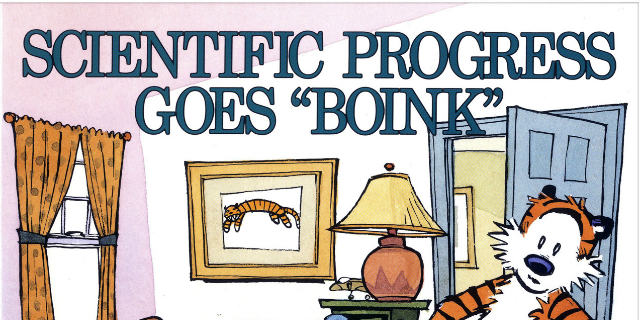Gary Larson tapped into the universal absurd.
Charles Schulz helped us identify with the underdog in us all. And Bill
Watterson accurately represented a father’s profound and boundless knowledge of
the universe, as in Calvin’s dad’s explanation that ice floats because, “It’s
cold. Ice wants to get warm, so it goes to the top of liquids in order to be
nearer the sun.” Or his explanation of relativity: “It’s because you keep
changing time zones. See, if you fly to California you gain three hours on a
five-hour flight, right?”
Again, and in the words of another cartoon sage,
“It’s funny because it’s true.” How true? Well, THIS
shows that preschool-aged children blindly accept adults’ explanations of
things without considering how the claims match real-world evidence. So
Calvin’s dad is scientifically copacetic: as we see in the comic, six-year-old Calvin
is just starting to tentatively doubt his dad’s explanations that, for example,
a bridge’s weight limit is determined by, “Driving bigger and bigger trucks
over the bridge until it breaks. Then they weigh the last truck and rebuild the
bridge.”
So will kids younger than Calvins believe
anything we tell them? When we wag our parental mouthparts in a preschooler’s
general direction, does the content matter? A study on
early view at the journal Child
Development says yes, and the implications for how kids use parents as
guides through the purgatory of questionable information goes far beyond
cartoons.

Compare the following answers to the question
“why does it rain?” used in the study:
1. Sometimes
it rains because it is wet and cloudy outside, and water falls from the sky.
When water falls from the sky it is called rain and rain gets us all wet.
2. Sometimes
it rains because there are clouds in the sky that are filled with water. When
there is too much water in the clouds, it falls to the ground and gets us all
wet.
The first is “circular” – notice that it
doesn’t really answer the question. In the experiment, the first answer was
attributed to a picture of a fictional female “explainer” in a black shirt and
the second answer was attributed to a female explainer in a green shirt. Then
the kids were given a picture of some new, ambiguous object. The experimenter
pointed out something about the object, for example saying, “I wonder why it
has a round thing there?”
The black-shirt and green-shirt explainers
gave their opinions about the object’s “round thing” and in this case both
explanations were equally valid: “It has a round thing so it can spin on the
table” or “it has a round thing so it can roll on the table.”
Which explainer did kids believe? You’re
probably ahead of the punch line: both 3yo and 5yo kids preferred the “round
thing” explanation delivered by the explainer who had come correct with a
linear explanation for the “why does it rain” question. They went back to the
person who they knew delivered the best information.
Here’s an interesting part: 5yos knew in their conscious minds which
explainer was better – when asked which was best, they pointed at the
non-circular explainer; 3yos couldn’t point at the better explainer, but their
unconscious preference for the better explainer showed that something
functioning below the surface of their developing, Dora-obsessed minds knew the
difference.
The authors from Boston University write, “Taken
together, preschoolers are surprisingly selective, not only in using single
words but also in using entire utterances to judge an informant’s credibility.”
Read that again: the quality of the
explanations you offer to your children will influence their perception of your
credibility. Not only that, but your explanations will influence how likely
your kids are to ask you for explanations in the future.
Here’s the funny thing: according to
this study, Calvin’s dad was spot on. Though his explanations may have slightly
stretched what we adults narrowly think of as scientific credibility, they are
linear, logical and – at least to the brain
of a young child who hasn’t yet pruned branches from the tree of possibilities
– perfectly plausible. That’s why Calvin goes back for more: the quality (if
not content) of his dad’s explanations allow dad to continue as Calvin’s oracle
of information.
Make sure your explanations answer the
question instead of parading around the topic and you can do the same.


